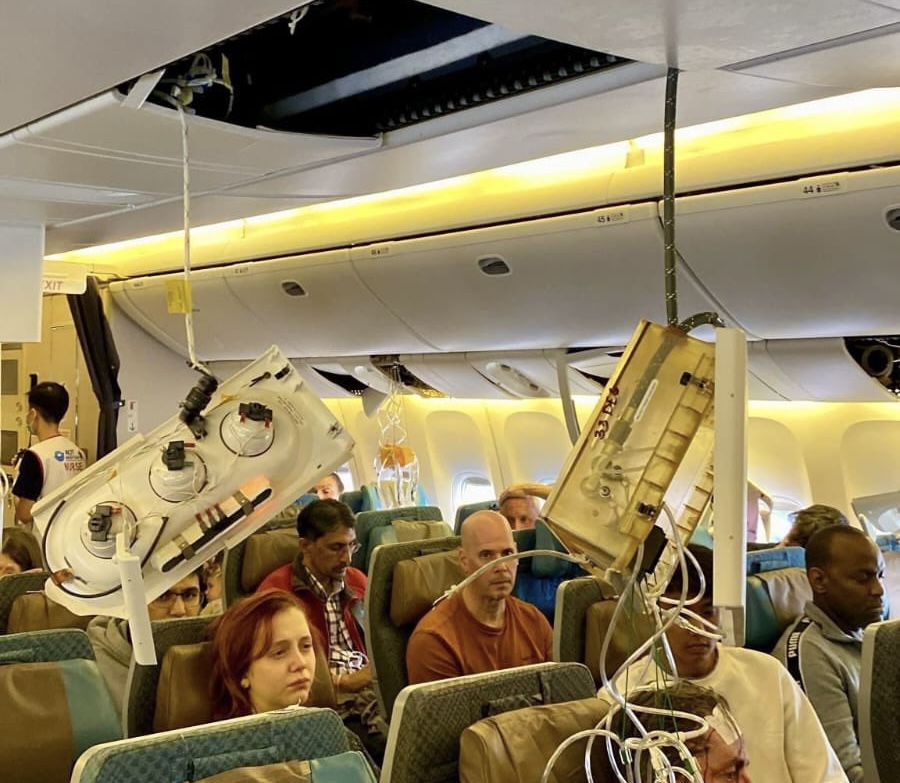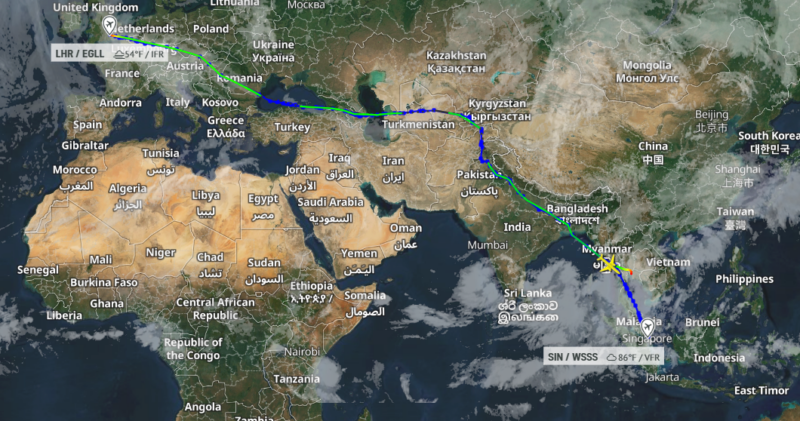On May 21, 2024, a Singapore Airlines Boeing 777 en route to Singapore encountered fatal turbulence resulting in a diversion to Bangkok. The aircraft hit severe turbulence, causing one fatality and injuring 30 occupants on board.
The Boeing 777-300ER with registration 9V-SWM was operating flight SQ321 from London Heathrow to Singapore with 211 passengers and 18 crew members on board. However, while the B777 was cruising at FL370 about 210nm west-northwest of Bangkok, the aircraft suffered severe turbulence causing injuries to a number of passengers, as reported by the Aviation Herald.
After encountering turbulence amid a sudden fall in altitude, flight SQ321 descended to FL310 and diverted to Bangkok. The B777 landed on Suvarnabhumi Airport’s runway 19R around 30 minutes later without any further incidents.


Fatality, Injuries
One passenger was pronounced dead upon arrival, whereas 23 passengers and 7 crew members were taken to hospitals due to injuries. A British man, aged 73, was identified as the passenger who lost his life. The British man likely had a heart attack, according to reports.
Singapore Airlines confirmed there had been severe turbulence causing one fatality and multiple injuries on board flight SQ321. The airline later reported that 18 individuals have been hospitalized whereas another 12 are being treated in hospitals. Seven of these injured occupants are reportedly in critical condition.
“Singapore Airlines flight SQ321, operating from London (Heathrow) to Singapore on 20 May 2024, encountered severe turbulence en-route. The aircraft diverted to Bangkok and landed at 1545hrs local time on 21 May 2024. We can confirm that there are injuries and one fatality on board the Boeing 777-300ER. Singapore Airlines offers its deepest condolences to the family of the deceased.”
Singapore Airlines
According to reports, the speed over the ground of the Boeing 777 dropped rapidly by about 20 knots prior to starting the (controlled) descent from FL370 to FL310.
The ADS-B data also reveal that the aircraft had experienced an altitude deviation of -100/+300 feet about 350nm west-northwest of Bangkok while en route at FL370 over Myanmar about 15 minutes earlier.
UPDATE 17:00 Singapore Time
As of 1700hrs (Singapore Time) on 22 May 2024, Singapore Airlines can confirm that an additional five passengers who were on board SQ321 will be returning to Singapore today.
Another 74 passengers and six crew members are still in Bangkok. This includes those receiving medical care, as well as their family members and loved ones who were on the flight. One crew member is scheduled to return to Singapore tomorrow, 23 May 2024. We are actively reaching out to their family members and loved ones, where possible, to provide updates and offer any needed support.
“On behalf of the Singapore Airlines Board, I extend my deepest condolences to the family and loved ones of our passenger who passed away on 21 May 2024 in the SQ321 incident. I assure all passengers and crew members who were on board the aircraft that we are committed to supporting them during this difficult time. I also wish to express my gratitude to everyone in Singapore, Thailand, and around the world who are assisting those affected by this incident.”
Mr Peter Seah, Chairman of Singapore Airlines
Turbulence Prone Routes
The Santiago to Santa Cruz route is known for being particularly turbulent, but many flights worldwide face similar issues, as per the turbli database. Notably, flights departing from Tokyo frequently experience significant turbulence on long-haul routes, as reported by Bloomberg.
Turbulence arises due to varying reasons based on the landscape and region. For instance, on the Santiago-Santa Cruz route, turbulence is caused by Pacific and Atlantic winds crossing the Andes at right angles.
The equator is also famous for turbulence due to strong vertical air currents and frequent thunderstorms. Moreover, Japan’s high turbulence levels are attributed to its mountainous regions and oceanic surroundings.
Feature Image via FL360aero




